
Italian postcard by Edizioni Artistiche Alberani. Portrait by Nanni. Alberani was a Bologna-based pharmaceutic company, which for decades made publicity for its 'sali di frutta'. Here Vittorio De Sica is clearly associated with the Jazz Age.
Italian director Vittorio De Sica (1901-1974) was a leading figure in the Neorealist film movement. De Sica directed 34 feature films, for which he won numerous international prizes including four Oscars. As an actor, he made more than 150 films and is best known for his 1930s comedies with Assia Noris and his postwar earthy comedies in which he played bright and charming roles opposite sex goddesses Gina Lollobrigida and Sophia Loren.

Italian postcard by Ed. Art. Alberani. Portrait by Nanni. Publicity for Sali di Frutta Alberani.
Nino Besozzi (1901-1971) was a popular Italian comical stage and screen actor, who excelled in 1930s Italian comedy. Another association with the Jazz Age.

Italian postcard by Ed. Branca. Portrait by Nanni / Metro-Goldwyn-Mayer. Publicity for Fernet Branca liquor. The card may refer to Gish's film Romola (Henry King, 1924), set in Renaissance Florence and partly shot on location in Italy, but the dress and hairdo on the card don't appear in the film.
American actress Lillian Gish (1893-1993) was 'The First Lady of the Silent Screen'. During the 1910s, she was one of director D.W. Griffith's greatest stars. She appeared in features such as The Birth of a Nation (1915), Broken Blossoms (1919), and Orphans of the Storm (1921). After 13 years with Griffith, she moved to MGM where her first picture was La bohème (1926).

Italian postcards by Edizioni Artistiche Alberani. Portrait by Nanni.
Isa Miranda (1905–1982) was the only international film star produced by the Italian fascist cinema. In Hollywood, she was billed as the ‘Italian Marlene Dietrich’ and played femme fatale roles. Later she became one of the most significant European film actresses during the 1940s and early 1950s.

Italian postcard by Ed. Branca. Portrait by Nanni / Artisti Associati (United Artists). Dolores del Río was a beloved star in Italy. She visited Rome in 1928 and was filmed by the Italian newsreel company LUCE then. See Youtube. Del Rio was filmed leaving the hotel Excelsior and visiting Castel Sant'Angelo, the Colosseum, and the university. She was almost crushed by the wild students.
Mexican and American actress Dolores del Río (1905–1983) was a Hollywood star in the 1920s and 1930s, and one of the most important female actresses of the Golden Age of Mexican cinema in the 1940s and 1950s. Del Río was the first major Latin cross-over star in Hollywood and was considered one of the most beautiful faces that have emerged in Hollywood cinema. She also appeared in several European films.

Vintage Italian postcard. Portrait by Nanni. Sponsored by Fernet-Branca liquor.

Vintage Italian postcard. Portrait by Nanni. Sponsored by Fernet-Branca liquor.

Italian postcard (reproduction). Portrait by Nanni. This card refers to Garbo's silent depiction of 'Anna Karenina', entitled: Love (1927). In 1935 she did a sound version too.
Swedish Greta Garbo (1905-1990) was one of the greatest and most glamorous film stars ever produced by the Hollywood studio system. She was part of the Golden Age of the silent cinema of the 1920s and was one of the few actors who made a glorious transition to the talkies. She started her career in European cinema and would always stay more popular in Europe than in the USA.

Italian postcards by Ed. Art. La Rinascente. La Rinascente is a famous Italian department store. Portrait by Nanni.
Charming and elegant Vera Vergani (1894-1989) was primarily an Italian stage actress, famous for her interpretations in the first stagings of Pirandello’s plays. She became one of the popular divas of the Italian cinema when she appeared in a dozen silent films between 1917 and 1921 for directors like Augusto Genina and Roberto Roberti.
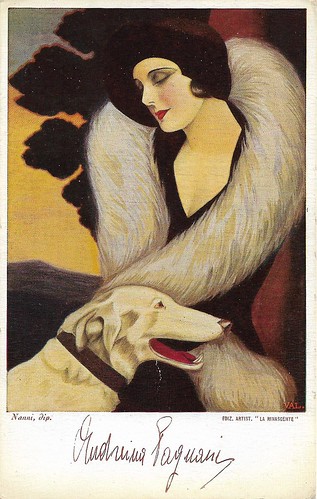
Italian postcard by Edizioni Artistiche La Rinascente. Portrait by Nanni.
Andreina Pagnani (1906-1981) was an Italian actress and voice actress. She was a primadonna of the Italian theatre but also appeared in silent and sound films. She became popular as Maigret's wife in the TV series Le inchieste del commissario Maigret/The Investigations of Commissioner Maigret (1964-1972).

Italian postcard by Ed. Art. Alberani. Artwork by Nanni. The painting is based on a part of a still of La signora di tutti/Everybody's Woman (Max Ophüls, 1934). See also this postcard.
Franco Coop (1891-1962) was a highly prolific actor in Italian sound cinema from the early 1930s onwards. In La signora di tutti/Everybody's Woman (Max Ophüls, 1934), Mario Ferrari and Franco Coop as the producer and the agent challenge each other when striking a deal over film star Gaby Doriot (Isa Miranda).

Italian postcard by Ed. Art. Alberani. Portrait by Nanni. Behind Sergio Tòfano the character of Signor Buonaventura, Tofano's popular creation,.
Sergio Tòfano (1886-1973) was an Italian actor, director, playwright, scene designer, and illustrator. He specialised as a comic actor, giving his role a new elegance and complexity. He interpreted works of multiple authors going from Molnár to Shaw. After the Second World War, he worked with the most important innovative stage directors such as Luchino Visconti and Giorgio Strehler. His film acting career set off with the early sound film comedy La segretaria privata/The Private Secretary (Goffredo Alessandrini, 1931), starring Elsa Merlini. Many other comedies at Cines-Pittaluga followed in the early 1930s.

Italian postcard. Design by Giovanni Nanni. Publicity for Sali di Frutta Alberani. The historical costume may refer to the Italian historical film Lorenzino de' Medici (Guido Brignone, 1935), in which Camillo Pilotto plays the perfidious Duke Alessandro, who covets Lorenzino de' Medici 's (Alexander Moissi) sweetheart (Germana Paolieri).
Camillo Pilotto (1888-1963) was an Italian stage and screen actor.

Italian postcard by Ed. Art. Alberani. Portrait by Giovanni Nanni. Publicity for Sali di Frutta Alberani.
Luigi Cimara (1891-1962) was an Italian actor in silent and sound cinema, television, radio, and theatre. Cimara was a major stage actor between the 1910s and 1950s. In cinema, he was the love interest of the Italian silent divas in the late 1910s and early 1920s. Between the 1930s and 1950s, he often played supporting parts as aristocrats in Italian sound films.
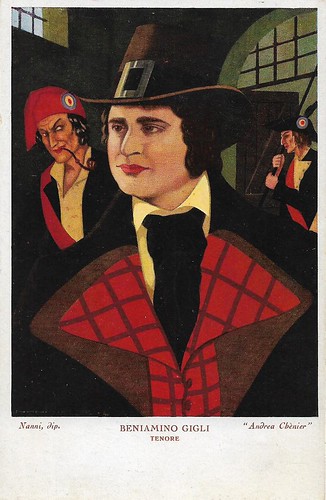
Italian postcar by La Voce del Padrone, S.A. Nazionale del Grammofono, Milano. Artwork by Nanni. Beniamino Gigli as the title character in the Italian opera 'Andrea Chénier' (1896) by Umberto Giordano, libretto by Luigi Illica.
Beniamino Gigli (1890-1957) was one of the most famous Italian opera singers, internationally respected for the beauty of his voice and his vocal technique. Between 1935 and 1950 he also starred in various Italian fiction films.

Italian postcard by Ed. Artistiche Alberani. Portrait by Nanni. Feodor Chaliapin as Mephistopheles in 'Faust' by Gounod.
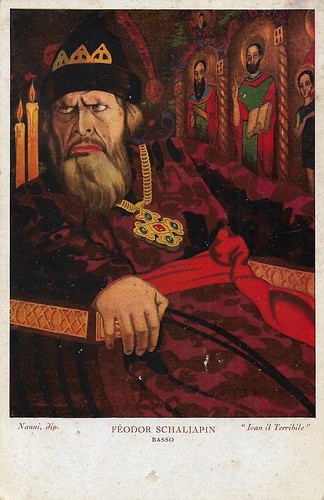
Italian postcard by S.A. Nazionale del Grammofono, Milano, in the series 'artists of La Voce del Padrone' (His Master's Voice). Portrait by Nanni. The bass Feodor Ivanovich Chaliapin as Ivan the Terrible in 'The Maid of Pskov' by Nikolai Rimsky-Korsakov.
Russian opera singer Feodor Ivanovich Chaliapin (1873–1938) was the possessor of a large, deep, and expressive bass voice. He enjoyed an important international career at major opera houses and is often credited with establishing the tradition of naturalistic acting in his chosen art form. In 1922, he settled in Paris and performed at the Paris Opera,. His acting and singing were sensational. He made many sound recordings between 1900 and 1938, of which the 1913 recordings of the Russian folk songs 'Vdol po Piterskoi' and 'The Song of the Volga Boatmen' are best known. The only sound film which shows his acting style is Don Quichotte/Don Quixote (Georg Wilhelm Pabst, 1933).

Italian postcard. Portrait by Nanni. Soprano Toti Dal Monte as the title character in the Donizetti opera 'Lucia di Lammermoor', one of her famous performances, together with Donizetti's 'Elisir d'amore' and Puccini's 'Madama Butterfly'. Reproduction.
Toti Dal Monte (1893-1975) was a celebrated Italian operatic soprano. She may be best remembered today for her performance as Cio-cio-san in Puccini's Madama Butterfly', having recorded this role complete in 1939 with Beniamino Gigli as Pinkerton. Debuting at the Scala in 1916, it was during an American tour that conductor Arturo Toscanini discovered the perfect talent of the young singer and let her perform again at the Scala in 'Rigoletto'. From then, a golden career followed in the 1920s and 1930s. She also achieved great successes in cinema, starring in the films Il carnevale di Venezia (Giuseppe Adami, Giacomo Gentilomo, 1939) and Cuore di mamma (Luigi Capuano, 1954), as well as in a cameo in Enrico Maria Salerno's Anonimo veneziano (1970).

Italian postcard. Portrait by Nanni. Tenor Antonio Cortis as the painter Mario Cavaradossi in the opera 'Tosca' by Puccini. You can hear him sing the famous aria 'E lucevan le stelle' from 'Tosca' at YouTube (recording of 1929).
Antonio Cortis (1891-1952) was a Spanish tenor with an outstanding voice. He was acclaimed by audiences on both sides of the Atlantic for his exciting performances of Italian operatic works, especially those by Giuseppe Verdi, Giacomo Puccini, and the verismo composers such as Mascagni. Between 1925 and 1930 he made many recordings of operatic arias and songs for HMV and Victor. After a three-year contract in Rome (1920-1922) and a long contract with the Chicago Civic Opera (1924-1932) he settled in Spain because of the Depression in the US. By the mid-1930s and the onset of the Spanish Civil War, he stopped singing.

Italian postcard, a postwar reproduction (1960s?). Portrait by Nanni. Tito Schipa (tenor) in 'Rigoletto'.
Tito Schipa (1888-1965) was an Italian tenor of Albanese descent. He was considered the best 'tenore di grazia' (light tenor) in history. Schipa also acted in various Italian sound films of the 1930s and 1940s.
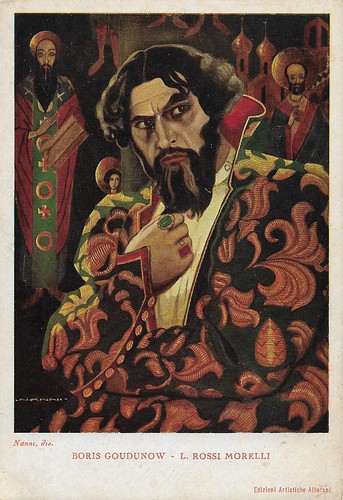
Italian postcard by Edizioni Artistiche Alberani. Portrait by Nanni. Luigi Rossi-Morelli in 'Boris Godunov'. Caption: Pastiglie Madonna della Salute contro le tosse (Madonna della Salute tablets against coughs).
Luigi Rossi-Morelli (1887-1940) was an Italian baritone. During the 1930s, he appeared at La Scala over and over again and counted as the most significant Wagner baritone in Italy.

Italian postcard by Edizioni Artistiche Alberani. Portrait by Nanni. Gina Cigna in the opera 'Fra Diavolo' by Auber. Caption: Pastiglie Madonna della Salute contro le tosse (Madonna della Salute tablets against coughs).
Geneviève Cigna, known as Gina Cigna (1900-2001) was an Italian singer of French origin. She was one of the great dramatic sopranos of her time. She made her debut at La Scala in Milan in 1927, under the name Ginette Sens, in the role of Freia in 'Das Rheingold' but it went unnoticed. In 1929, she made a second debut at La Scala, under the name of Gina Cigna, in 'Donna Anna'. It was a triumph. She thus established herself as the star dramatic soprano of La Scala, where she sang in operas such as 'Il trovatore', 'Un ballo in maschera', 'Aida', and 'Tosca'. However, her name remains mainly associated with 'Norma', 'La Gioconda', and 'Turandot', her favorite roles, which she sang on all the major stages. Her career ended abruptly in 1948 when she was the victim of a car accident.

Italian postcard by Edizioni Artistiche Alberani. Portrait by Nanni. Aureliano Pertile in the opera 'Isabeau' by Mascagni. Caption: Pastiglie Madonna della Salute contro le tosse (Madonna della Salute tablets against coughs).
Italian tenor Aureliano Pèrtile (1885-1952) was chosen by Giacomo Puccini to interpret 'La rondine' in 1917 Three years later, he had great success in 'Mefistofele' and 'Aida', at the Verona Arena. In 1922, Arturo Toscanini chose him to play 'Mefistofele' again at La Scala. It started his partnership with the great director at the Scala theater. Pertile was considered the "tenor of Toscanini" par excellence and participated in almost all the opera seasons of La Scala until 1937.

Italian postcard by Edizioni Artistiche Alberani. Portrait by Nanni. Luigi Montesanto. Caption: Pastiglie Madonna della Salute contro le tosse (Madonna della Salute tablets against coughs).
Luigi Montesanto (1887-1954) was an Italian baritone. In 1909, he made his debut in 'Carmen' in Conegliano Veneto, and with the same opera, he made his debut at La Scala in the 1912-1913 season. In 1918, he was the first interpreter of Giacomo Puccini's 'Il tabarro' at the Metropolitan. Montesanto had a brilliant international career and sang in Lisbon, Moscow, Madrid, Paris, Prague, Buenos Aires, and Chicago. Between 1909 and 1936, he interpreted at the Teatro Massimo many operas including 'La bohème', 'Tristan', 'La Gioconda', and 'Rigoletto'.

Italian postcard by Edizioni Artistiche Alberani. Portrait by Nanni. Duilio Baronti in the opera 'Lucia di Lammermoor' by Donizetti. Caption: Pastiglie Madonna della Salute contro le tosse (Madonna della Salute tablets against coughs).
Duilio Baronti was a popular bass singer at the Italian opera. In the season 1930-1931, he sang at the Scala in Milan the part of Raimondo in Donizetti's 'Lucia di Lammermoor'. On the whole, Baronti was between 1929 and 1932 a regular of the Scala, in operas by Verdi, Gounod, Wagner, Mozart, Ponchielli, Puccini, etc. In 1935 he sang opposite Aurelio Pertile in the premiere of Mascagni's 'Nerone'.
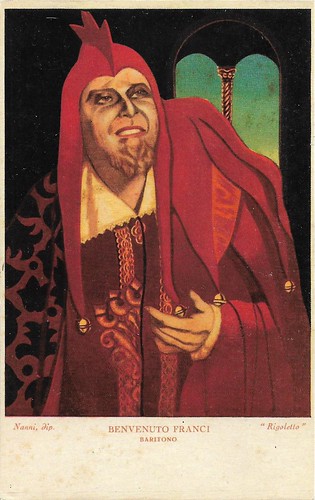
Italian postcard. Portrait by Nanni.
Benvenuto Franci (1891-1985) was a very versatile Italian opera singer. His voice was beautiful and toned and suited the dramatic, committed roles of the baritone repertoire well. He made his debut at the Teatro Costanzi (the present Teatro dell' Opera) in Rome in the role of Giannetto in the opera 'Lodoletta' by Pietro Mascagni in 1918. Soon after, also in Rome, he played the role of Pharaoh in Rossini's 'Moses', and Ford in Verdi's 'Falstaff'. He later sang in the world premiere of Mascagni's opera 'Il piccolo Marat', and as Amonasro in Verdi's 'Aida'. His career continued brilliantly at the Liceu in Barcelona, at the Teatro Real in Madrid, and at the Arena in Verona, and at Covent Garden in London. At the Teatro Alla Scala in Milan, he sang starting from 1923.


Italian postcards. Art by Nanni. Nani depicts typical Parisians of the 'Apaches' low-life, often represented on stage and on film. Captions: Nella via / Dans la rue / In the street. Reproduction.

Italian postcard. Artwork by Nanni. During the First Word War Nanni made many of these sentimental, romantic scenes on departing or returning officers and soldiers.
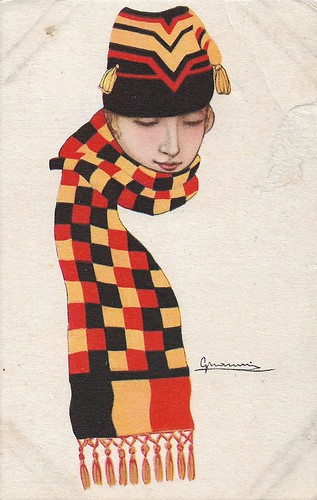
Italian postcard by Uff. Rev. Stampa, Milano, 22-3-1917. Artwork by Giovanni (Nanni). Nanni did a series with lady shawls representing the flags of the allies during WWI. This picture refers to the Belgian flag.

Italian postcard. Artwork by Nanni. During the First World War Nanni made many postcards that display the latest fashion in ladies' hats.
Source: Lungomarecastiglioncello (Italian).
This post was last updated on 11 December 2021.
No comments:
Post a Comment